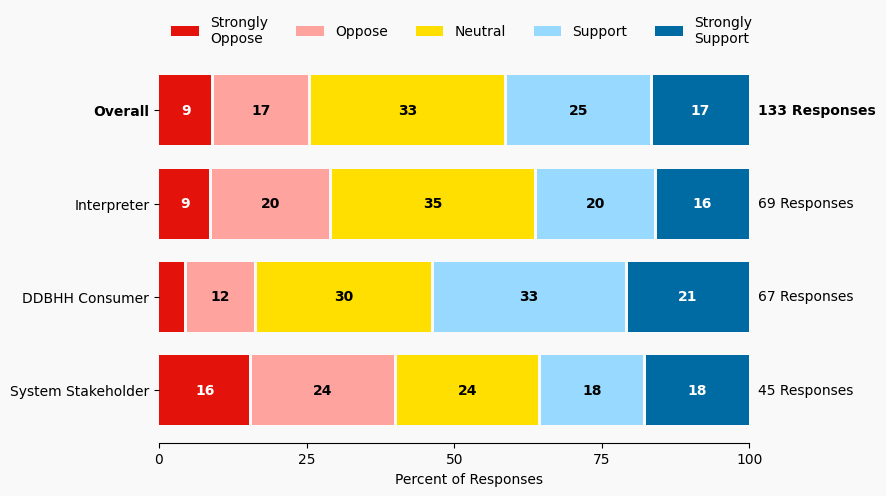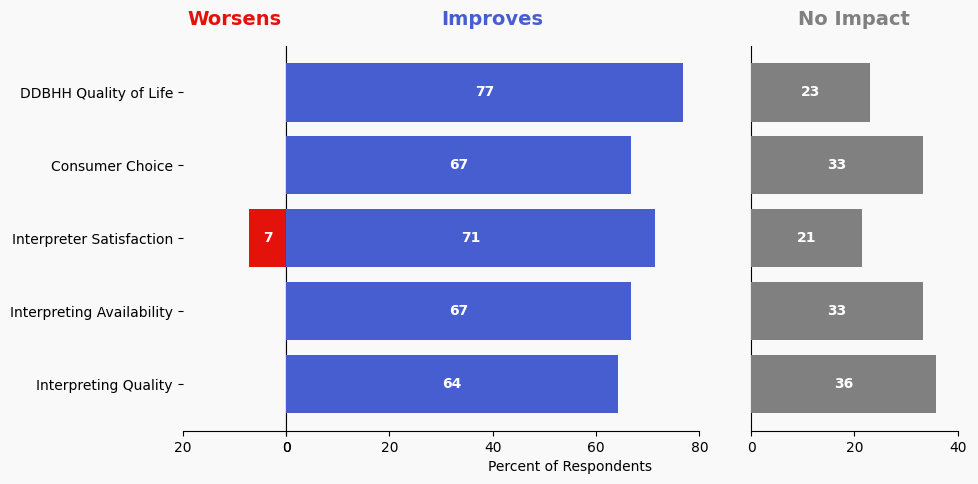19 Centralize Referral System under Minnesota Commission
Issue: All current interpreter referral companies are private, for-profit entities.
Proposed Solution: Parallel to the Massachusetts Commission for the Deaf and Hard of Hearing (and others), the Minnesota Commission could establish an interpreting component of their office. The interpreting department could include interpreter referral and setting standards for statewide practices, similar to Massachuestts.
Expected outcome: Unknown what impacts would come from an interpreter referral department under the Commission. Increased competition and more options for freelance interpreters are the primary expected outcomes.
Who is impacted: Hiring entities, interpreters
Timeline: 6 months
Note: MCDHH Communication Access Division – https://www.mass.gov/communication-access-services-division-cas-division

Summary of Support Image Description
The stacked bar charts show how respondents rated their level of support and the total number of responses. The percentage for the five support levels is shown from left to right: Strongly Oppose (Dark Red), Oppose (Light Red), Neutral (Yellow), Support (Light Blue), and Strongly Support (Dark Blue).
Respondents may identify with multiple subgroups. The overall level of support is:
Overall
Strongly Oppose: 9%
Oppose: 17%
Neutral: 33%
Support: 25%
Strongly Support: 17%
Click to see the detailed image description for each subgroup.
Interpreter
Strongly Oppose: 9%
Oppose: 20%
Neutral: 35%
Support: 20%
Strongly Support: 16%
DDBHH Consumer
Strongly Oppose: 4%
Oppose: 12%
Neutral: 30%
Support: 33%
Strongly Support: 21%
System Stakeholder
Strongly Oppose: 16%
Oppose: 24%
Neutral: 24%
Support: 18%
Strongly Support: 18%
Overview of Respondents Opting for In-Depth Solution Analysis
After indicating their support level, 12% of the 133 respondents opted in to further assess whether the solution would worsen or improve on five metrics. Of the opt-in reviewers (17 respondents), 41% supported the solution, 23% were neutral on the solution, and 35% opposed the solution.
The remaining 116 respondents did not opt in to further assess the solution. Of these people, 41% support the solution, 34% were neutral on the solution, and 24% opposed the solution.
Reviewer Evaluation of Solution Effectiveness

Solution Effectiveness Image Description
The stacked bar charts show how respondents assessed the effectiveness of this solution based on five metrics. For each metric, the percentage of respondents is shown from left to right: Worsens (Red), Improves (Blue), No Impact (Gray).
DDBHH Quality of Life
Makes It Worse 0%
Makes It Better 76%
No Impact 23%
Interpreter Satisfaction
Makes It Worse 7%
Makes It Better 71%
No Impact 21%
Consumer Choice
Makes It Worse 0%
Makes It Better 66%
No Impact 33%
Interpreting Availability
Makes It Worse 0%
Makes It Better 66%
No Impact 33%
Interpreting Quality
Makes It Worse 0%
Makes It Better 64%
No Impact 35%
Reviewer Feedback and Insights
Interpreter
Comments from Interpreters raise concerns about whether the centralized system would complement or replace existing agencies, referencing past challenges with similar systems. One comment suggests that a centralized system might help increase the fill rate and manage job flow, though concerns about quality control and maintaining flexibility remain. Comments also question the feasibility of state management in a context where VRI and other agencies are already active.
Deaf, DeafBlind, Hard of Hearing
Comments from DDBHH Consumers emphasize the need for careful planning to ensure that the system does not disrupt existing services or lower the quality of interpreting during its transition.
System Stakeholder
Comments from System stakeholders express reservations about government-managed services, citing potential efficiency issues and the risk of stifling competition. One comment highlights the challenges of securing ongoing legislative funding and the need for transparent, intentional planning. One comment suggests ensuring that any centralized system complements private referral agencies rather than replacing them.
PREVIOUS SOLUTION
18 Establish Licensure for Interpreters
Issue: Concerns about interpreter quality or other complaints are not being resolved via the current mechanisms of RID or interpreter referral companies..
NEXT SOLUTION
20 Make Interpreters State Employees
Issue: Interpreters working with government agencies experience varied levels of compensation, standards required, support and benefits.
Leave a Reply